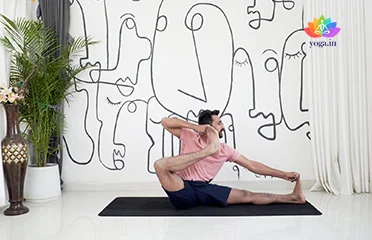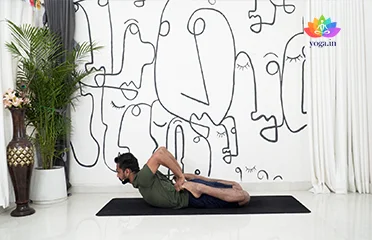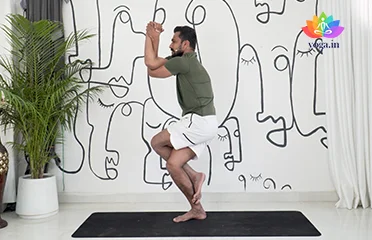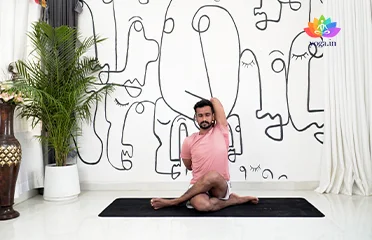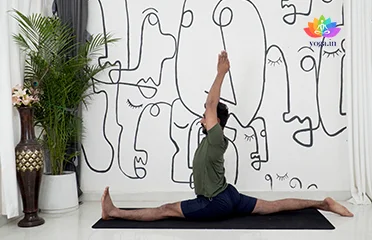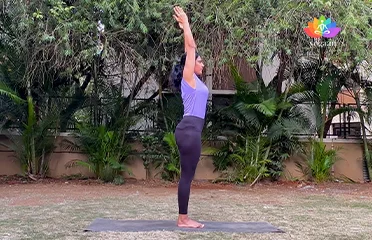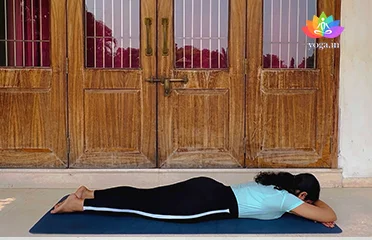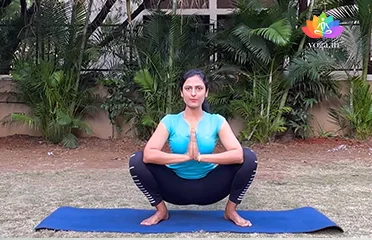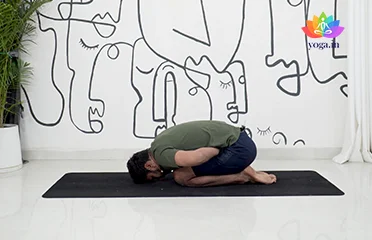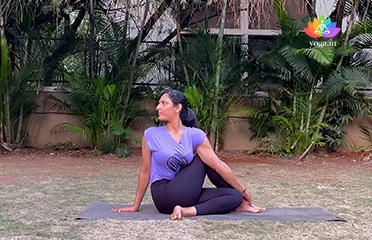Akarna Dhanurasana (Archer Pose)
अकर्णा धनुरासन / Archer Pose
The Sanskrit name is derived from Akarna (अकर्णा ) meaning towards [�K]
Bhekasana (Frog Pose II)
भेकासन / Frog Pose II
The Sanskrit name is derived from Bheka (भेका) meaning frog and asana [�K]
Garudasana (Eagle Pose)
गरुडासन / Eagle Pose
The Sanskrit name is derived from Garuda (गरुडा) meaning eagle and [�K]
Gomukhasana (Cow Face Pose)
गोमुखासन / Cow Face Pose
The Sanskrit name is derived from Gau (गो) meaning cow, Mukh meaning face [�K]
Hanumanasana (Monkey Pose)
हनुमानासन / Monkey Pose
The Sanskrit name is derived from the Hindu God -Hanuman (हनुमान) [�K]
Hastapadasana (Hand to Foot Pose)
हस्तपदासन / Hand to Foot Pose
The sanskrit name is derived from hasta (हस्त) means hands, pada (पदा) [�K]
Makarasana (Crocodile Pose)
मकरासन / Crocodile Pose
The Sanskrit name is derived from Makara (मकरा) meaning crocodile and [�K]
Malasana (Garland Pose)
मालासना / Garland Pose
The Sanskrit name is derived from Mala (माला) means garland or rosary [�K]
Mandukasana (Frog Pose)
मण्डुकासन / Frog Pose
The Sanskrit name is derived from Manduka (मण्डुका) meaning frog [�K]
Matsyendrasana (Lord of the Fishes Pose)
मत्स्येन्द्रासन / Lord of the Fishes Pose
The name Matsyendrasana is derived from the Sanskrit words Matsya (मत्स्य) [�K]
- 1
- 2
How Yoga Can Help Cure Gout:
Gout is a type of arthritis characterized by sudden, severe attacks of pain, redness, and swelling in the joints. Yoga can help manage and alleviate the symptoms of gout by promoting relaxation, reducing inflammation, and improving joint flexibility. Through specific postures, breathing exercises, and relaxation techniques, yoga can help reduce the frequency and severity of gout flare-ups.
Understanding Gout:
Gout is a form of inflammatory arthritis caused by an excess of uric acid in the blood, leading to the formation of urate crystals in the joints. These crystals can trigger intense pain, swelling, and redness, often affecting the big toe, but can also occur in other joints. Gout can be acute (sudden and severe attacks) or chronic (persistent joint pain and damage).
Yoga’s Role in Relieving Gout:
Specific yoga practices can help alleviate the symptoms of gout by improving joint flexibility, reducing stress, and enhancing overall well-being. These include gentle asanas (postures) that do not strain the affected joints, pranayama (breathing exercises) that promote relaxation, and meditation techniques that reduce stress and inflammation.
Key Factors Contributing to Gout:
Several factors can contribute to the development of gout, including:
- Genetic Predisposition: A family history of gout increases the risk.
- Diet: High intake of purine-rich foods like red meat and seafood can increase uric acid levels.
- Obesity: Excess body weight can raise uric acid levels and increase the risk of gout.
- Alcohol Consumption: Excessive alcohol intake can interfere with the removal of uric acid from the body.
- Medical Conditions: Certain conditions like hypertension and diabetes can contribute to gout.
- Medications: Some medications, such as diuretics, can increase uric acid levels.
Symptoms of Gout:
Common symptoms of gout include:
- Intense Joint Pain: Sudden and severe pain, often in the big toe, but can occur in other joints.
- Swelling: The affected joint becomes swollen and tender.
- Redness: The skin around the affected joint becomes red and inflamed.
- Heat: The affected joint feels warm to the touch.
- Limited Range of Motion: Joint mobility may be restricted during gout attacks.
- Lingering Discomfort: After the severe pain subsides, joint discomfort may persist.
Treatment of Gout through Yoga and Pranayama:
Yoga and pranayama can be highly effective in managing gout. Some beneficial practices include:
Specific Yoga Poses:
- Supta Padangusthasana (Reclining Hand-to-Big-Toe Pose): Improves joint flexibility and reduces stiffness.
- Ardha Matsyendrasana (Half Lord of the Fishes Pose): Helps detoxify the body and improve digestion.
Pranayama Exercises:
- Anulom Vilom (Alternate Nostril Breathing): Balances the mind and reduces stress.
- Sheetali Pranayama (Cooling Breath): Helps reduce body heat and inflammation.
Diet for Gout:
A balanced diet can help manage gout. Recommendations include:
- Low-Purine Foods: Include fruits, vegetables, whole grains, and low-fat dairy products.
- Hydration: Drink plenty of water to help flush uric acid from the body.
- Cherries: Eating cherries may help reduce uric acid levels and inflammation.
- Lean Proteins: Choose lean sources of protein like chicken, fish, and tofu.
- Limit Alcohol: Reduce or avoid alcohol, especially beer and spirits.
Caution for Gout:
While practicing yoga for gout, it is essential to:
- Avoid Overexertion: Practice at a gentle pace to prevent strain on the affected joints.
- Be Mindful of Pain: Stop immediately if any pose causes discomfort or pain.
Always consult with a healthcare provider before starting any new exercise regimen, especially if you have severe gout.
Contraindications for Gout:
Individuals with severe gout or significant joint pain should:
- Avoid Intense Yoga Practices: Vigorous exercises might exacerbate symptoms.
- Steer Clear of Certain Poses: Poses that put pressure on the affected joints may increase discomfort.
- Seek Professional Guidance: Consult a yoga therapist or healthcare professional for personalized recommendations.


